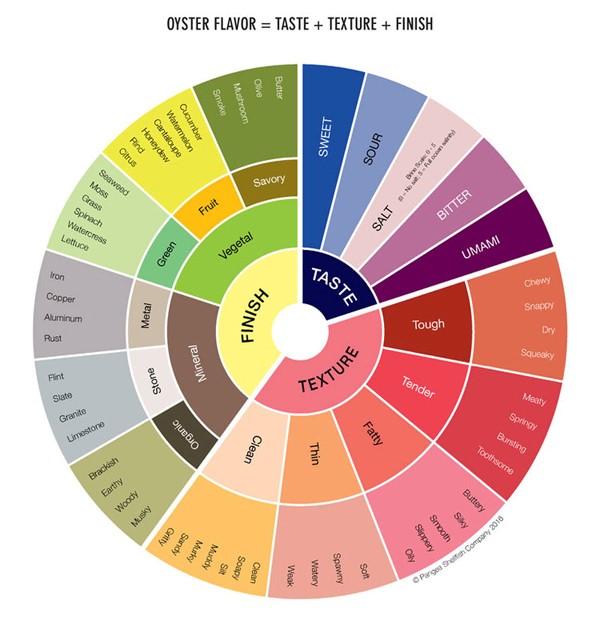OYSTERS 101
Oysters have been a part of the human diet for thousands of years. They are eaten on six of the seven continents! Just like wine, oysters can vary greatly in appearance, taste, and texture depending on where they’re from.

FUN FACT

FUN FACT
Since oysters filter water, they ingest all naturally occurring plankton, bits of plant life, salt and minerals from the water they grow in. The biological makeup of seawater can vary greatly bay to bay, ocean to ocean, and especially north to south. This drastically alters all aspects of the oyster that lives in the various bodies of water.
Since oysters filter water, they ingest all naturally occurring plankton, bits of plant life, salt and minerals from the water they grow in. The biological makeup of seawater can vary greatly bay to bay, ocean to ocean, and especially north to south. This drastically alters all aspects of the oyster that lives in the various bodies of water.
EAST COAST OYSTERS
1. TERRIOR
Oysters get their food by constantly filtering water, therefore acquiring unique flavor profiles and varied shell shapes according to their environments. It is important to understand how oysters’ native terrior contributes to differences in appearance, texture and shape.
East: Grown sub-tidally, meaning lying always below water and in colder temperatures.
2. SHELL SIZE, SHAPE & COLORATION
East:
-Develop smoother shells with rounded edges and relatively shallower shells
-They are bigger, 2-6 inches in diameter
-Come in shades of brown, green, and white
3. FLESH TEXTURE & FLAVOR PROFILE
East:
-Colder waters slow down the metabolism of oysters, producing crisp-textured bivalves
-Higher in salinity, brininess, and minerality
THE ETIQUETTE OF TASTING
There are many ways to enjoy a good oyster, but there are some “rules” of tasting that should not be broken.
RULE #1
Do NOT pour out the oyster’s liquor.
It is a precious part in tasting an oyster and is considered to be essential to the oyster-tasting process. When a fresh oyster is shucked masterfully, a small pool of clear liquid will remain with the oyster in the bottom half of the shell. It is actually filtered sea water from which the oyster lived in, and holds a robust, unique to-that-oyster flavor.
RULE #2
Taste the first oyster naked.
Meaning without garnish or condiments. We know that an oysters’ flavor can become repetitive, but for the first couple oysters always recommend trying it “naked” in order to taste its’ true flavor. You can only get the pure, unadulterated essence of the oyster if you try it by itself!
RULE #3
Chew the oyster 3 to 4 times
Throwing back oyster shooters is fine, but should never be done with premium oysters. Chewing the oyster breaks down the glycogen in the meats, releasing sweetness and many other flavors that are only within the meats. Without chewing the oyster, you aren’t actually getting its full flavor!
RULE #4
Have a palate cleanser between different oysters
This is where our oyster crackers come in! The blandness of a cracker can cleanse the palate just as well as water. It absorbs the leftover particles in your mouth and cleans it thoroughly! This is important to ensure you’re always tasting the oyster you are slurping, not all of them together.
Oyster tasting is similar to wine tasting. You’re trying to absorb and appreciate the nuances in the flavor and textures of something that requires patience and mastery.
THE SIX S’S OF OYSTER TASTING
#1 SEE
Feast with your eyes! Study the shell, shape, and color.
#2 SMELL
It should smell sea-breezy and sweet, not fishy at all.
#3 SIP
Sip the oyster’s liquor to get a sense of the salinity.
#4 SLURP
Shimmy the oyster meat loose, tilt the flat edge of the shell to your lips and slurp! Don’t discard the oyster liquor (faux pas)
#5 SAVOR
Chew a few times to get the full body taste; notice the progression from nose (salty) to body (sweet/flavors) to finish (lingering aroma)
#6 SHELL
Flip the shell over and admire the collaboration between nature and farmer!

A master oyster list is available in the kitchen with all the types of oysters that the Oyster House has ever carried!
Get the Latest Updates
Sign up to receive emails about our hours, special offers & promotions, plus any other fun events!


